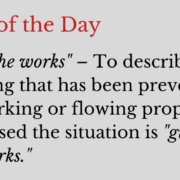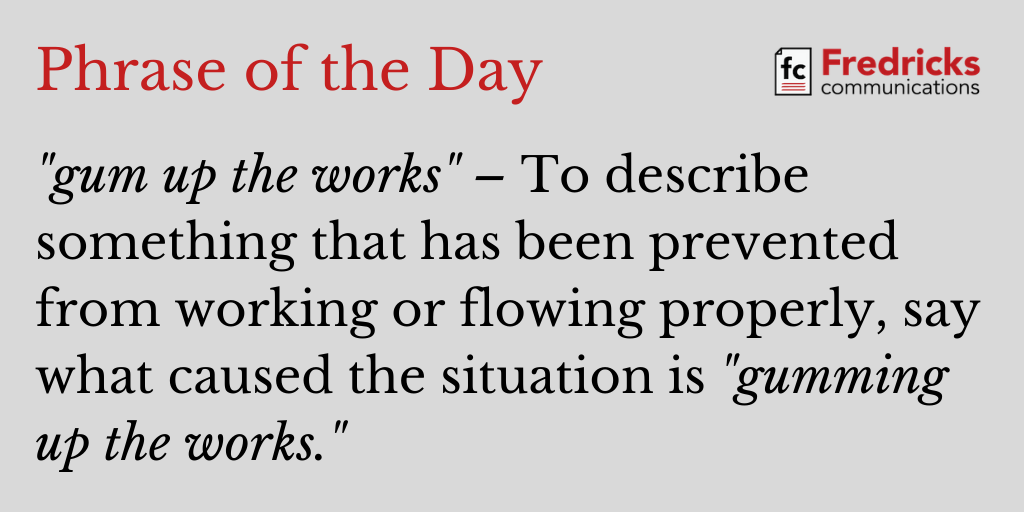Posts
Tip Tuesday – It’s Not Literally Dangerous in Copywriting, But…
/in Copywriting /by Martin Fredricks![]()
First, to be absolutely clear, no limbs will go flying when you use the word “literally” in your copywriting. Never in the history of the world has a written word literally caused an explosion. Except when terrorists or members of militaries write notes to each other.
Nevertheless, beware of using the word in your advertising and marketing content. Literally means something is fact, so using it to intensify a word or statement that follows is almost always incorrect.
“Our service will literally blow you away,” indicates your customers will, in fact, be lifted from their feet and tumble down the highway like so many tumbleweeds in a bad old Western when they experience your service. Or they will, in fact, be thrown back dozens of feet by a bomb blast.
Let’s be clear again. No one is going to take you seriously and expect to be lifted off of their feet, by wind, explosion or anything else.
But here’s the thing. What you’re trying to say, in a figurative way, is that your company’s service is incredible and your customers will be highly impressed and pleased.
Unfortunately, “Our service will figuratively blow you away,” doesn’t carry quite the same punch.
You just need to find a way to work that into your copy without resorting to literally or being insufferably dull.
Saying suspects, prospects or customers literally will be blown away isn’t dangerous – it won’t cause cancer and no one is going to get electrocuted – it’s just absurd. Your company won’t just look less than professional, it’ll look silly, like a company that really shouldn’t be taken too seriously.
If you see literally in your copywriting, a rewrite is in order. Seriously.
![]()
![]()
Tip Tuesday – In Order to Achieve Greater Impact…
/in Copywriting /by Martin FredricksTo be more concise and effective, always edit out “in order” and simply leave “to” in your advertising, marketing and public relations writing.
You’ll improve the impact, the POP!, of your writing without changing meaning almost every time.
Example:
- In order to achieve invigorating writing, use active voice.
- To achieve invigorating writing, use active voice.
Example:
- We provide technical training in order to increase your efficiency and reduce overall costs.
- We provide technical training to increase your efficiency and reduce overall costs.
But what about that pesky “almost” above?
Purists will spew some grammar mumbo-jumbo about how “in order to” is a subordinating conjunction. Huh? They’ll also say that when you drop “in order” you lose the underlying meaning of the phrase, which more clearly conveys intent than “to” alone. Your intent is to achieve invigorating writing, they’d say, and “in order to” conveys that more clearly. Same goes for the desire to increase efficiency.
They’re right. After all, they’re purists; being right is their job.
But who the heck even knows what a subordinating conjunction is. Right? Plus, here’s the thing –
Randomly ask 100 people which is more correct in those situations – “to” or “in order to” – and I’ll bet 99.99 percent of them won’t know the difference. Or give a rat’s patootie.
Which brings us back to Rule #2 for marketing writing: brevity.
(Rule #1 is to answer the Golden Question of Marketing – What’s in it for me?)
Dropping “in order” keeps your copy shorter, punchier.
It might not seem like much, but over the course of a longer brochure or training video, dropping the two extra words makes a difference.
If you’re writing a novel or an in-depth assessment of foreign affairs, by all means, write “in order to.” I don’t want you starting any wars because the intent of your sentences wasn’t absolutely clear.
Otherwise, go with “to,” especially in advertising, marketing and public relations.

Tip Tuesday – The Magnificent Seven of Copywriting References
/in Marketing /by Martin Fredricks
“Which reference books should copywriters have on their bookshelves?” I often get this question when I speak to groups. The quick answer is always, “Depends on the copywriter.”
As for this copywriter, I wouldn’t, and sometimes couldn’t, do the job without these seven magnificent tomes:
- Dictionary – Once upon a time, this one was obvious, but with the advent of online resources like dictionary.com and thesaurus.com, many writers have ditched their big, heavy, bulky dictionaries. Not me. Dictionary.com is great for making sure I’ve spelled words correctly, and thesaurus.com for identifying synonyms I already know but have slipped my mind. But for alternative or deeper meanings, or spelling variations, I keep the ol’ Oxford American close. Granted, I don’t use it very often, but when I need it, I’m glad it’s at hand.
- Associated Press Stylebook – Thanks to a former NDSU journalism professor, Lou Richardson, I learned how to use this invaluable handbook. Most news organizations in this region, along with many across the country, adhere to AP style, so I’ve referred to mine nearly every day of my writing career. AP purists will realize that I don’t follow it religiously from what they’d consider AP style errors in this post. All I can say to that is, marketing writing isn’t always the same as journalistic writing.
- The Gregg Reference Manual – The Gregg is handy for just about anything you either can’t find in the AP or when the AP rules don’t apply, like formal business communications.
- The Elements of Grammar by Margaret Shertzer
- The Elements of Editing by Arthur Plotnik
- The Elements of Style by William Strunk Jr. and E.B. White
- The Copywriter’s Handbook by Robert W. Bly – This is a great primer on marketing writing for the beginner and the seasoned veteran alike. I read it cover to cover – twice – before I started my first copywriting gig, and I still look back at it occasionally for specific thoughts, ideas or direction.
While there are more books on my shelves that I reference from time to time about advertising, brand development, copywriting, marketing and sales, like –
- Newswriting from Lead to 30 by Metz
- Positioning by Ries and Trout
- Brians’ Common Errors in English Usage
- Masello’s Roberts Rules of Writing
- Made to Stick by Heath & Heath
- A Kick in the Seat of the Pants and A Whack on the Side of the Head by Von Oech
– the seven at the top of this post are what I find indispensable in my day-to-day writing life. They’re my Magnificent Seven, constantly protecting me from the Malevolent Mistake Gang of bandits.
But only one copywriter really matters, and that’s you. Find the references that work for you, and for your purposes, actually read and use them, often, and your work will be better for it.

Tip Tuesday – In Copywriting, “Up” Gets the Thumbs Down
/in Copywriting /by Martin Fredricks
Elevate your copywriting – down with “up.”
All due respect to Mick and the rest of The Stones, but I do not want you to start me up. More specifically, I don’t want to see the phrase “start up” in any advertising, marketing or PR materials. In Mick’s words, it’s enough to “…make a grown man cry.” (Well, this one, anyway.)
For some reason, we Midwesterners love to add “up” to “start whenever we can:
- I wandered over to start up a conversation. / I wandered over to start a conversation.
- We started up deliveries in the southern part of the city about a month ago. / We started deliveries in the southern part of the city about a month ago.
- There’s a dude in a mask with a chainsaw coming! Start up your car and let’s get aych-e-double-toothpicks outta here! / There’s a dude in a mask with a chainsaw coming! Start your car, and let’s get aych-e-double-toothpicks outta here!
In each case, dropping the “up” makes the sentence shorter. (We’ll tackle the overuse of exclamation points in another Tuesday Tip, mmmmmmm-k?) The only time “start” and “up” should show up as a pair is when they form a compound adjective – “It’s a start-up venture.” And, let’s face it, the only place it has to go is up.
There’s no downside to dropping “up” from your advertising, marketing and public relations copywriting. I’d lose that if I were you.

Fredricks Communications
Fargo, ND USA
+1 701-261-0867
martin@fredrickscommunications.com

I am a proud member of Creatives for Climate (C4C), a not-for-profit and global network of thousands of professionals committing their creativity to driving positive impacts. C4C membership includes a commitment to avoid work with fossil fuels clients.
Fredricks Communications is a proud signatory of the Clean Creatives pledge to eschew work with fossil fuels companies and organizations. We’re a movement of advertisers, PR professionals and clients cutting ties with fossil fuels to fight climate change. Join us today!


Union Strong! I am a proud member of the Freelancers Union, the largest and fast-growing organization representing the 56.7 million independent workers across the country. Join today!



